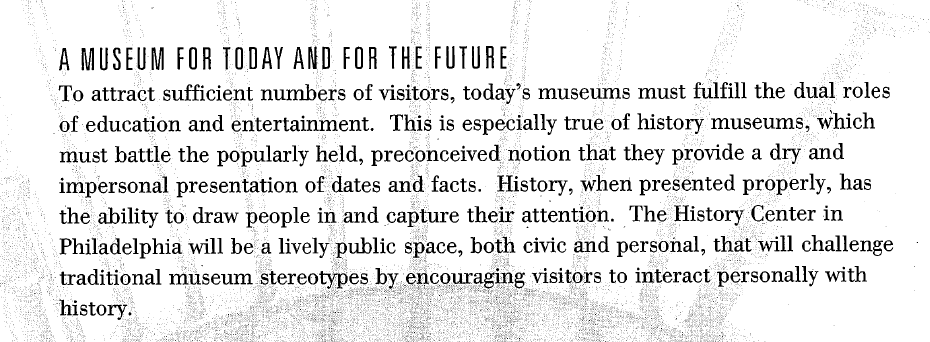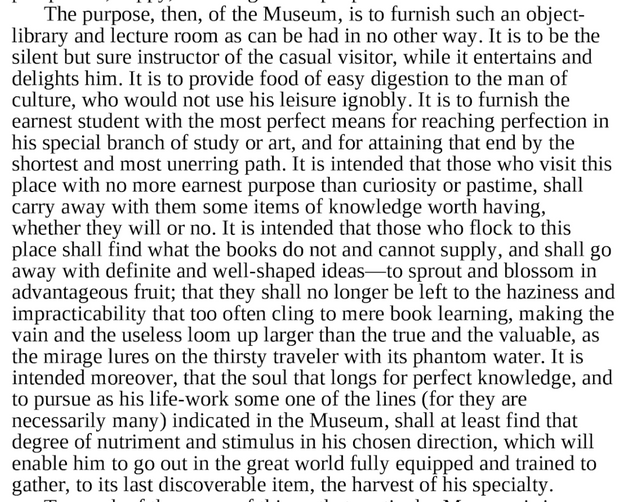Reflections on a (Flawed) Vision for a History Center in Philadelphia
In 1996, the Atwater Kent Museum and the Historical Society of Pennsylvania, two prominent Philadelphia-area history institutions, set forth a grand vision for The History Center in Philadelphia. The History Center was to function as a sort of clearinghouse for Philadelphia's rich history: telling narratives that would span the siloed foci of individualized institutions in the region. In addition, it was to raise the profile of other, smaller historical resources, encouraging more visitation by locals and tourists alike. The mission was framed as "a compelling need." [1] But this vision never fully materialized.
My most immediate response to the proposed project came as soon as I encountered this paragraph in the promotional material:

I was taken aback by this supposedly new and cutting-edge mission, because I'd just encountered something extraordinarily similar, an article entitled "The Museums of the Future," written by George Brown Goode, who worked as secretary of the Smithsonian's United States National Museum. Goode laid out an argument in 1891 that
"The museum of the past must be set aside, reconstructed, transformed from a cemetery of bric-a-brac into a nursery of living thoughts. The museum of the future must stand side by side with the library and the laboratory, as a part of the teaching equipment of the college and university, and in the great cities co-operate with the public library as one of the principal agencies for the enlightenment of the people." [2]
If this argument (and others dating from the 19th century) are still being put forth as innovative and unfulfilled, it is quite clear that the museum field generally, and the history museum field in particular, has a long way to go before it can achieve anything truly new.
The benefits are primarily financial. The Smithsonian has an endowed source of funding in addition to government and private funding sources. It has been able to leverage this financial "freedom" to put on blockbuster exhibitions, to assume the authority to tell a unified national historical narrative, and to provide partnership with other "affiliate" museums worldwide.
However, this has come at the expense of being able to take risks in presentation, theme, and topic. In attempting to tell a centralized story of American history, the Museum often fails to tell any significant portion of it in a comprehensive way. The "Enola Gay" exhibition controversy reveals that not even the Smithsonian is free to tell whatever story its historians and experts see fit, if public opinion demands otherwise. Centralized institutions cannot tell "bleeding-edge" stories. They cannot highlight how different narratives sometimes conflict, and they cannot advocate for specific constituencies at the expense of others. With big donors come big demands that prioritize stories complimentary to, and intended to sustain, the dominant power structures in a society. Many of the untold stories that the Smithsonian or the Philadelphia History Center would claim to want to tell are not compatible with this stricture.
100% of the SBD rewards from this #explore1918 post will support the Philadelphia History Initiative @phillyhistory. This crypto-experiment conducted by graduate courses at Temple University's Center for Public History and MLA Program, is exploring history and empowering education. Click here to learn more.
Works Cited
- The Vision for a History Center in Philadelphia (1996)
- George Brown Goode, “The Museums of the Future,” in Report of the National Museum, 1888-1889 (Washington, D.C.: Government Printing Office, 1891), 427–45, http://hdl.handle.net/2027/hvd.32044096986997.
Notable, I think, that Goode didn't include "entertainment" in his definition of the "new museum." I think that one of the biggest flaws in the History Center idea is the reliance on convenience and fun as essential to their value proposition. Museums should be meaningful and moving but not necessarily always comfortable. Right?
Good eye! You know as well as I do the early struggle between the P.T. Barnum model and the "learned societies." I've got another quotation for you from the very first director of the Met, Luigi Palma di Cesnola in 1887:

your post really good.thanks for shearing
So the 1996 proposal for a history center was just catching up to the late 19th century? No wonder it fell flat. But there were other reasons, too.
What would a history "center" look like in 2020?